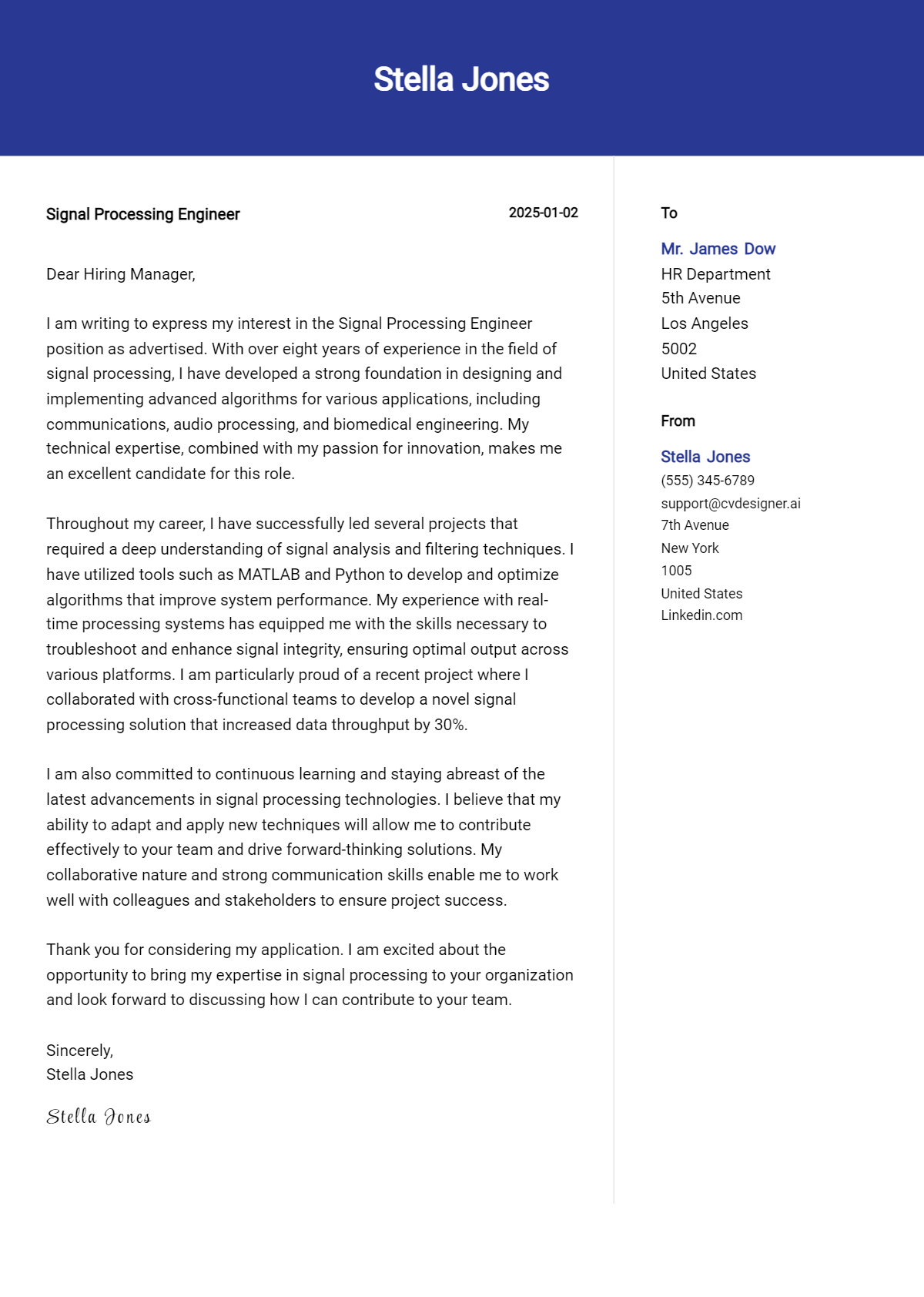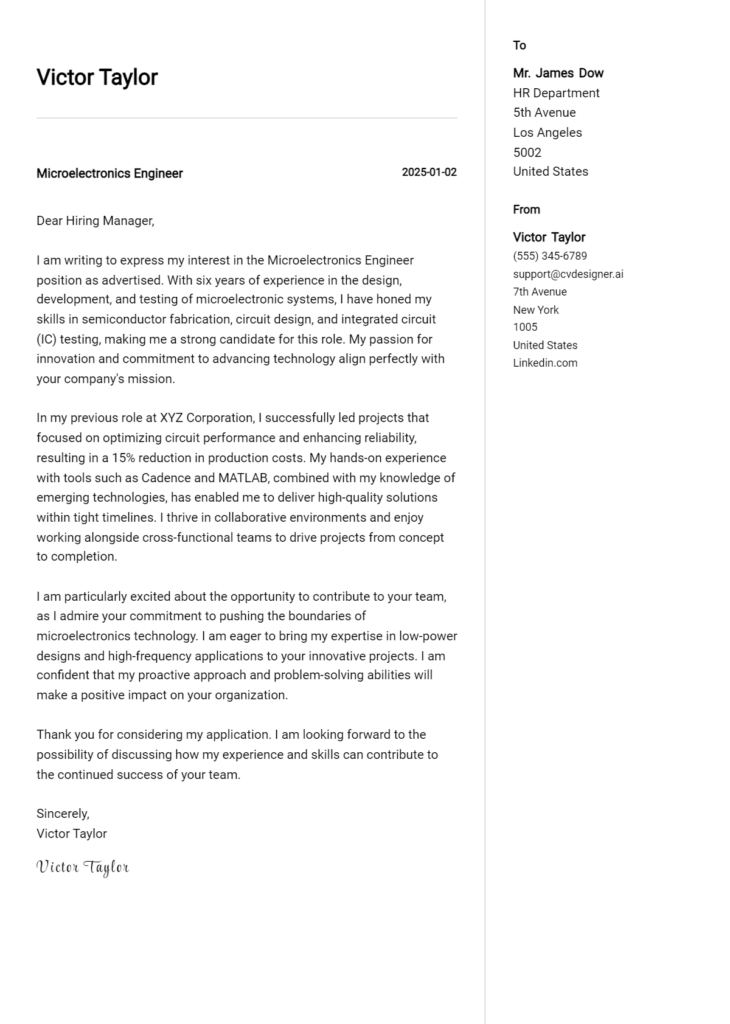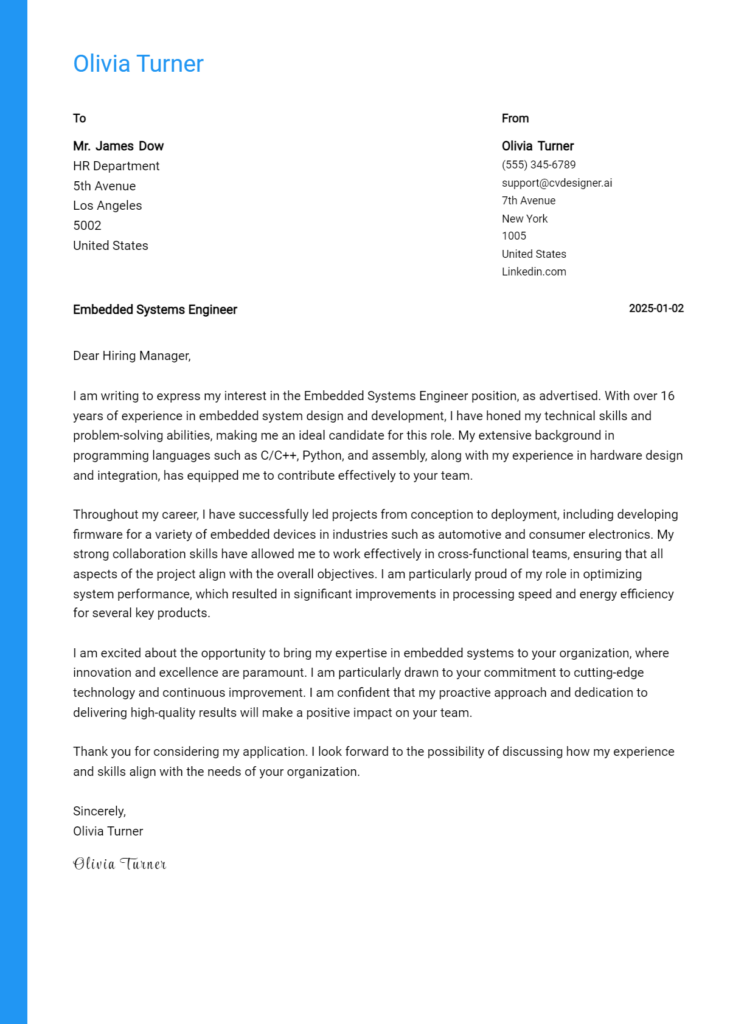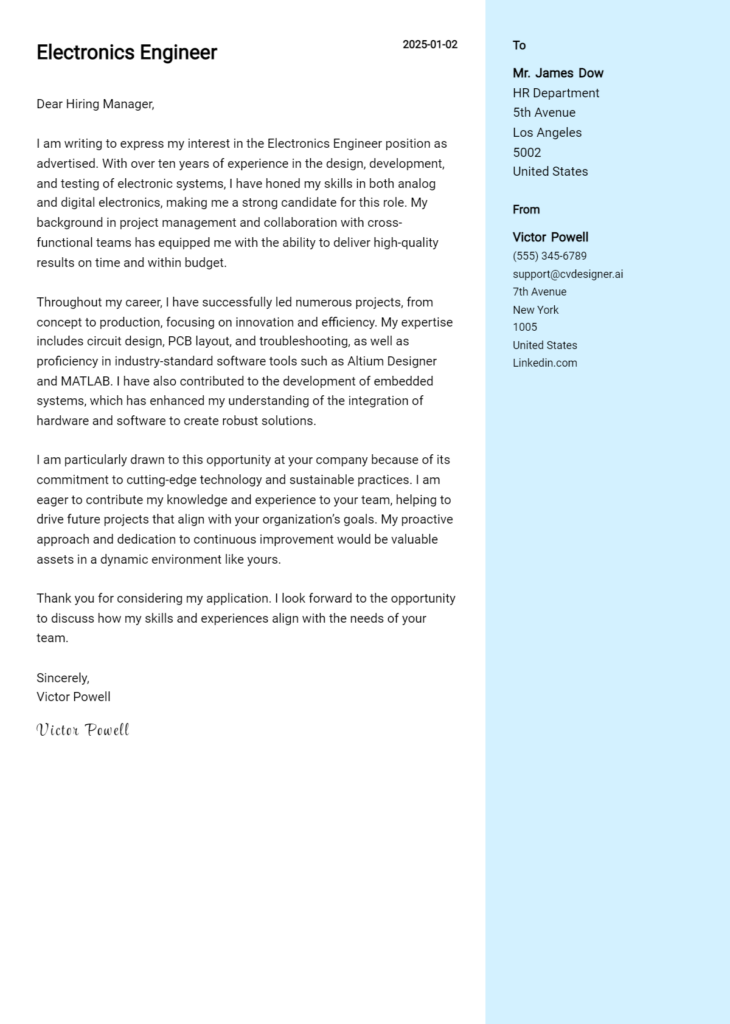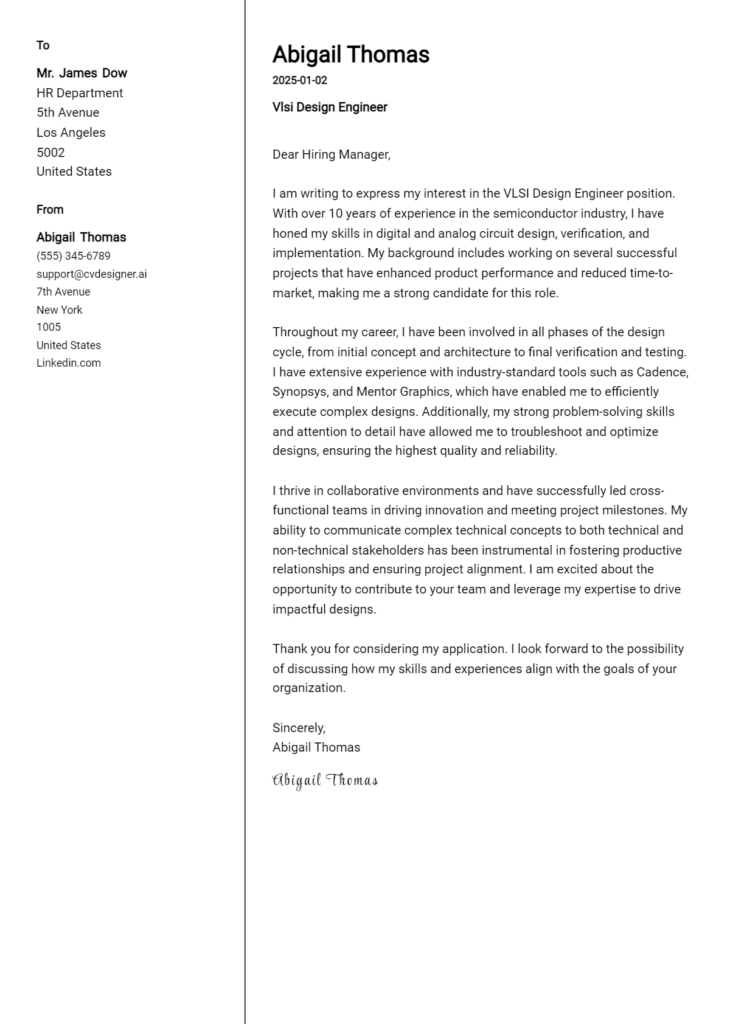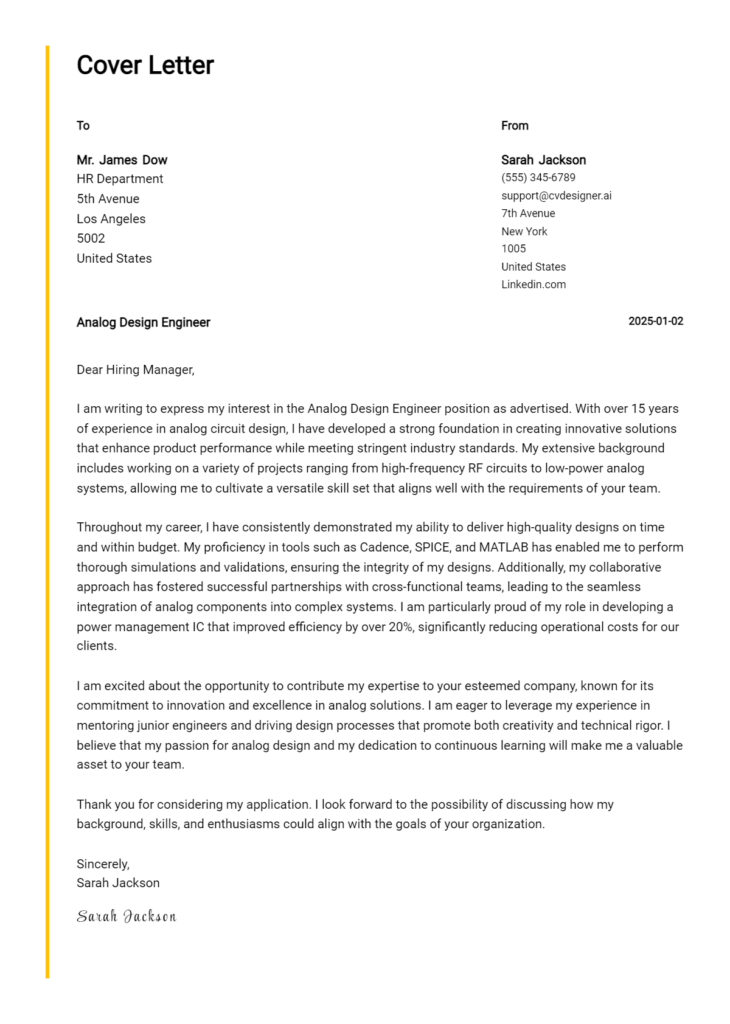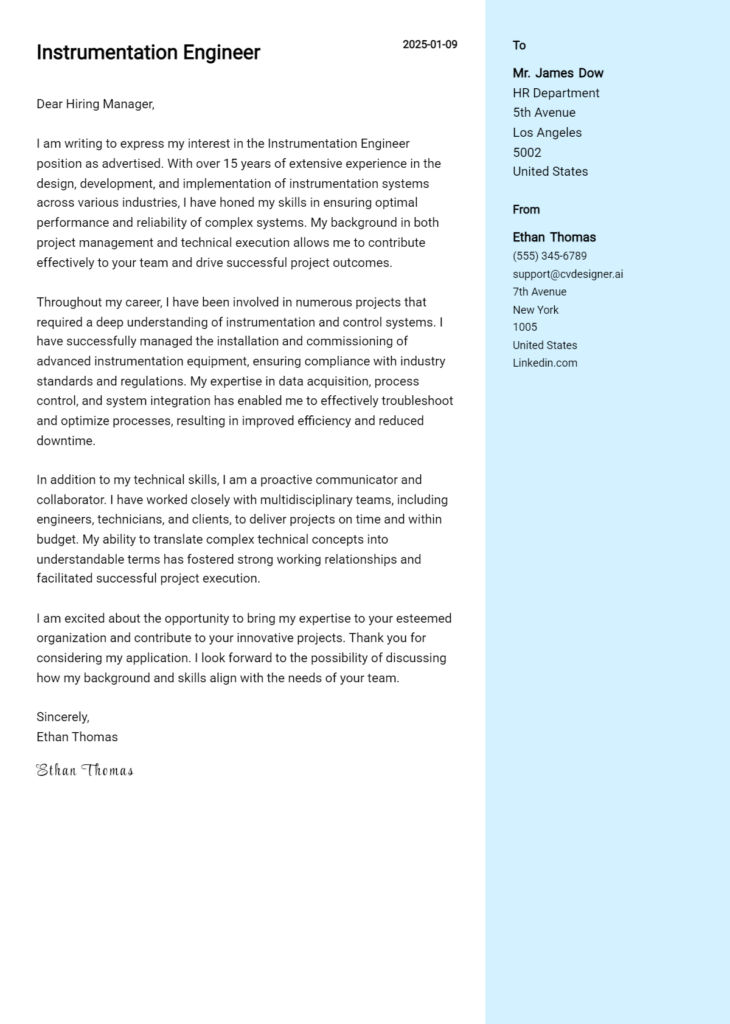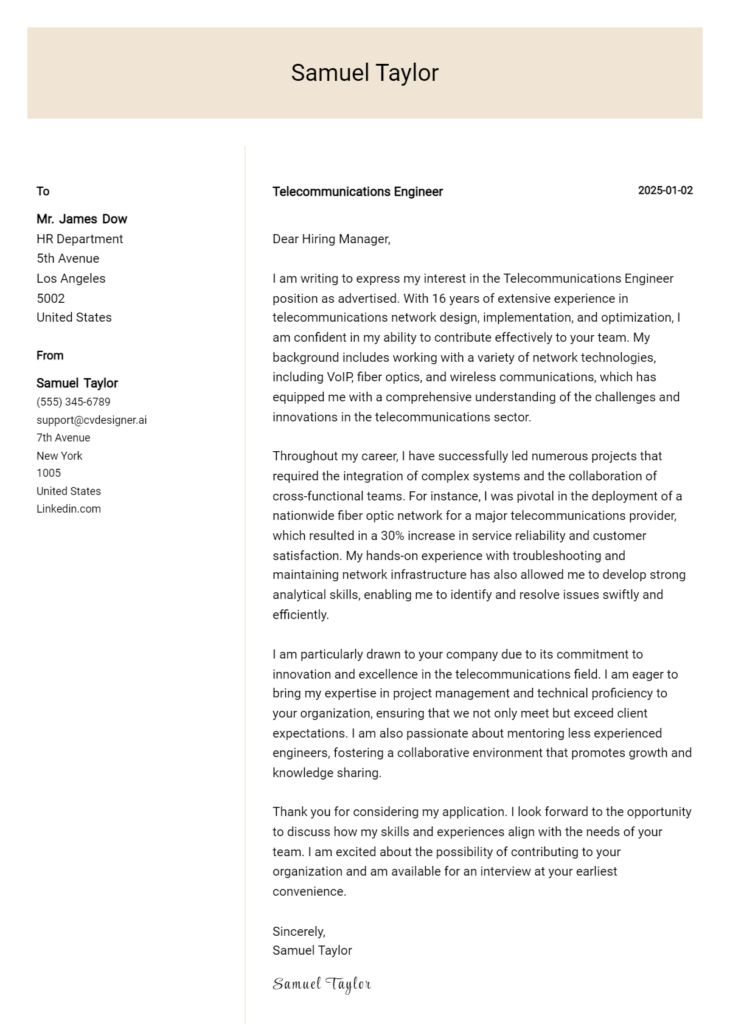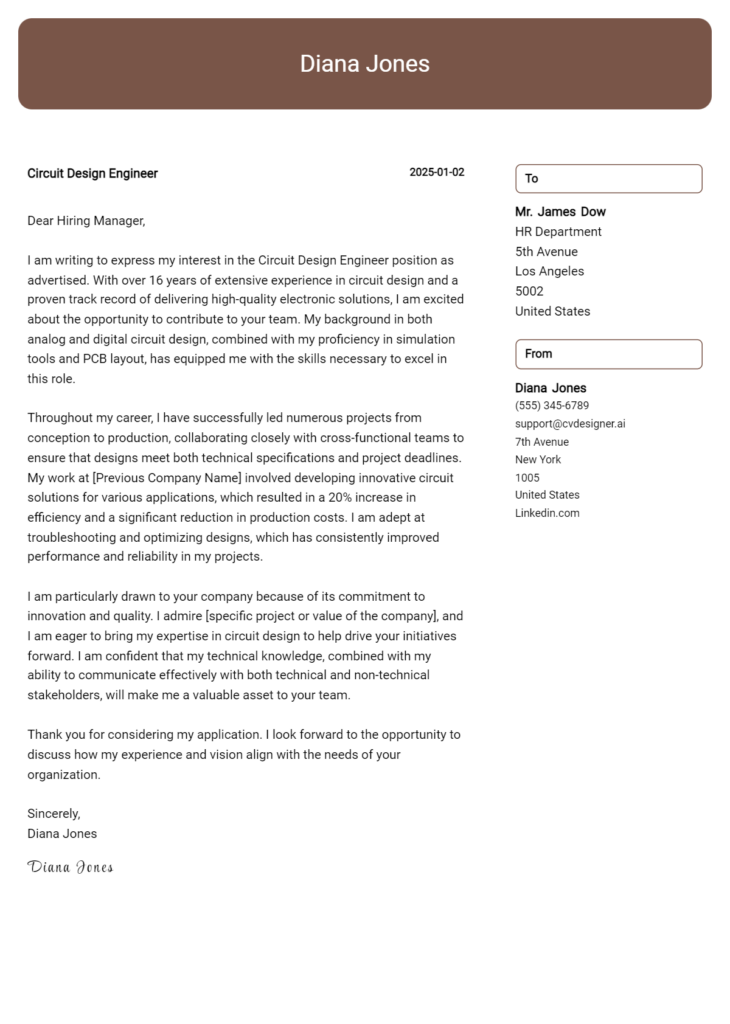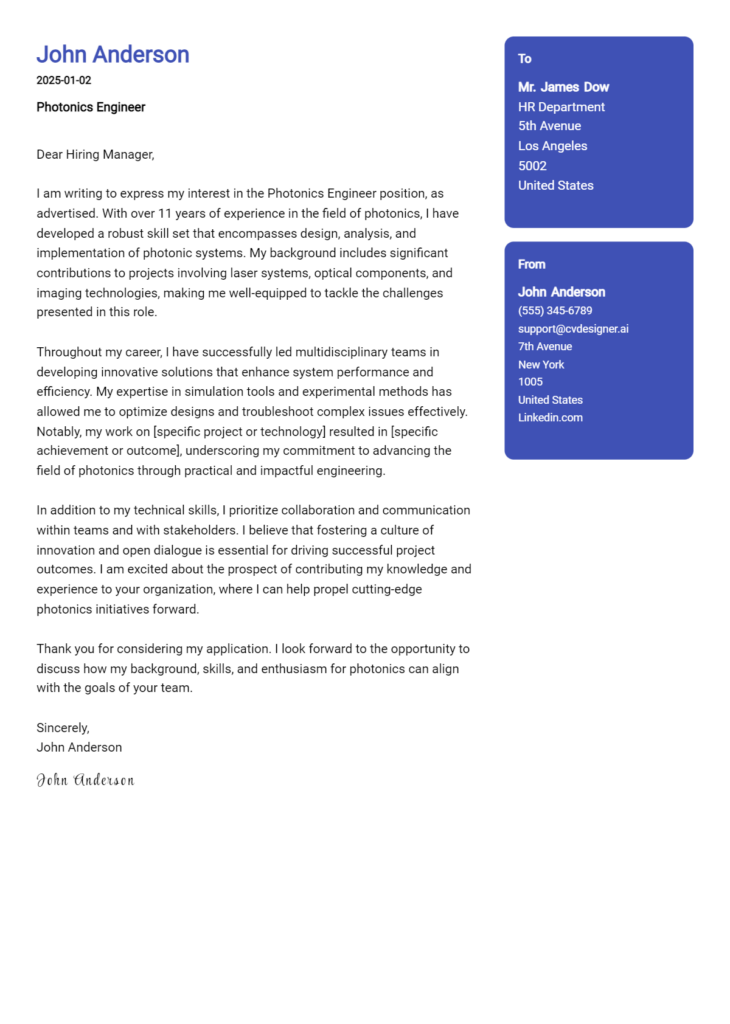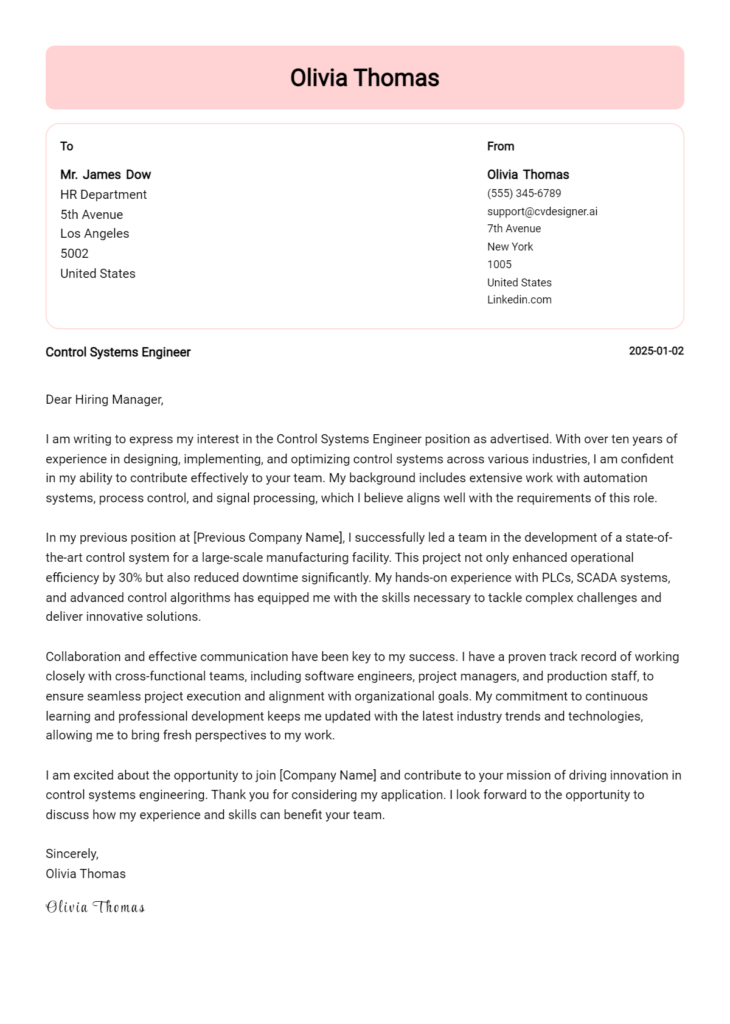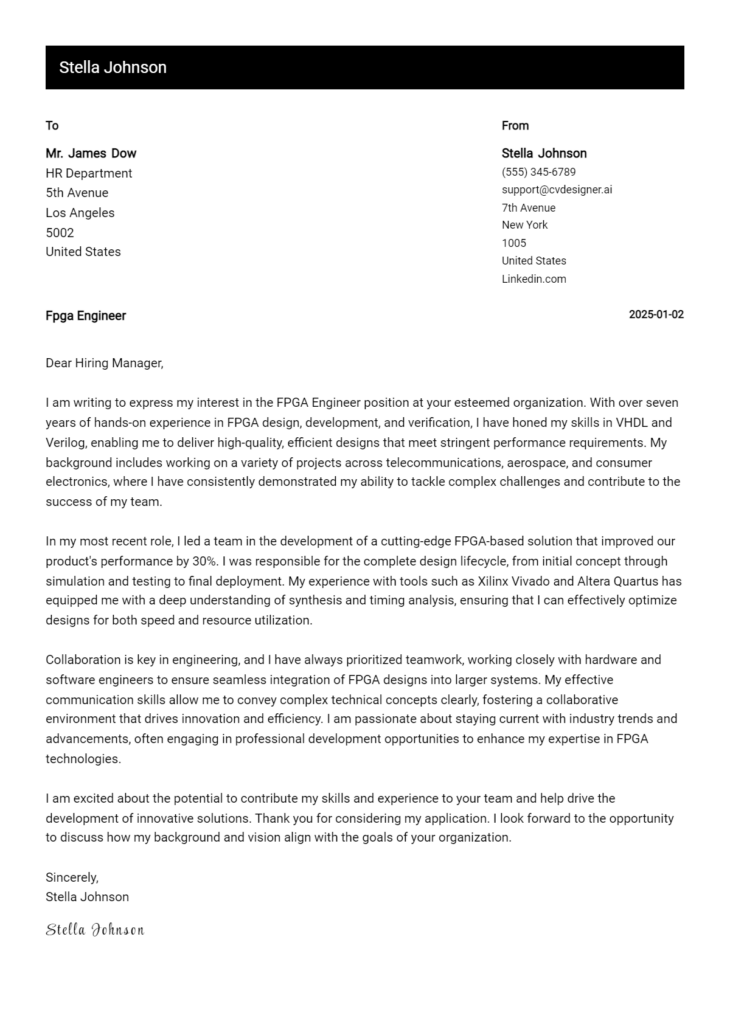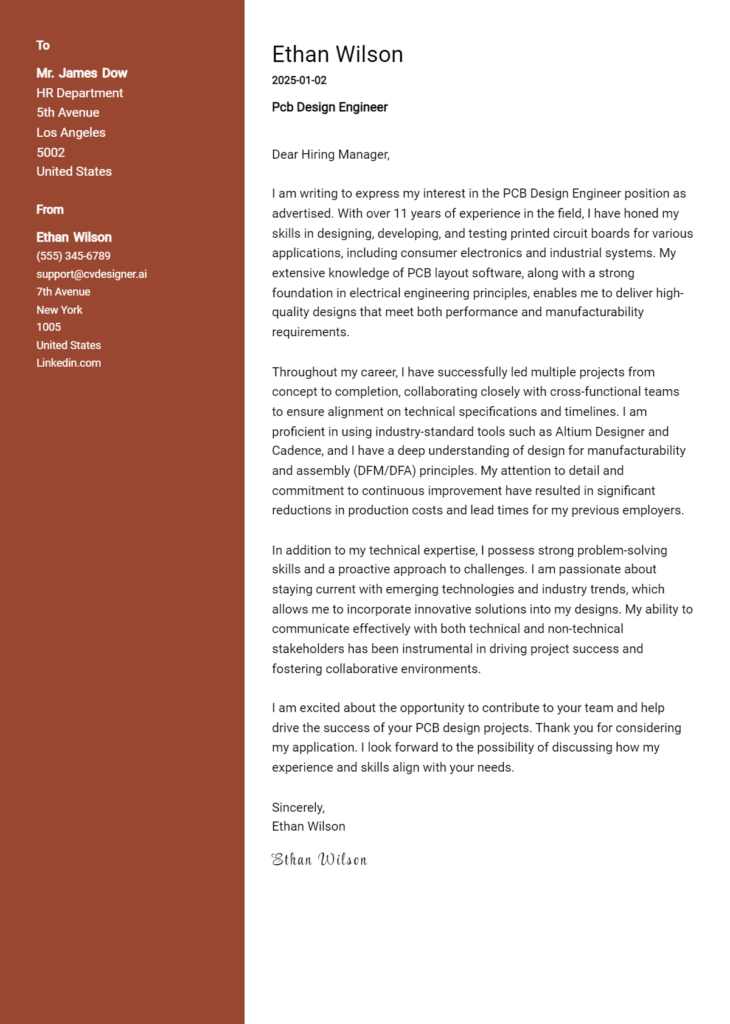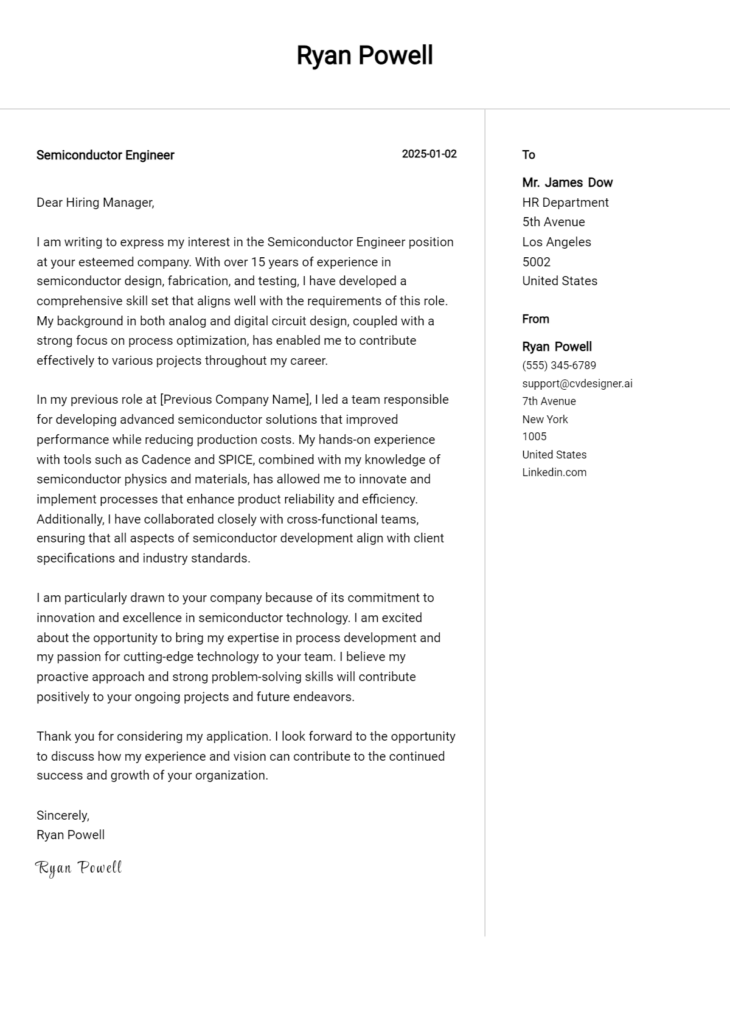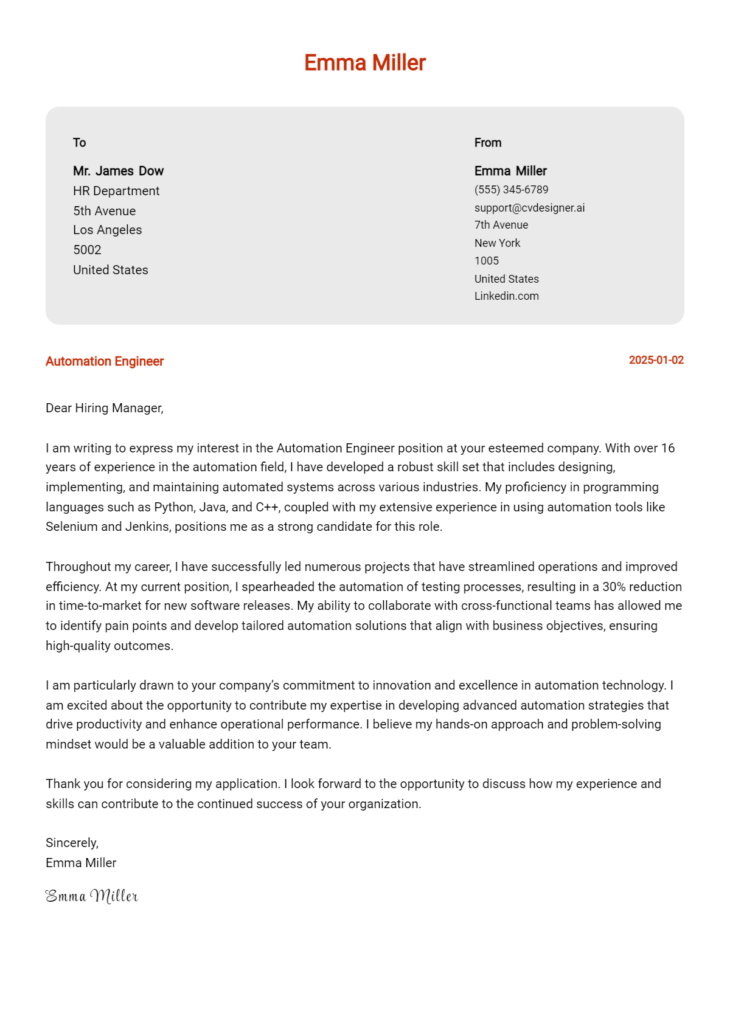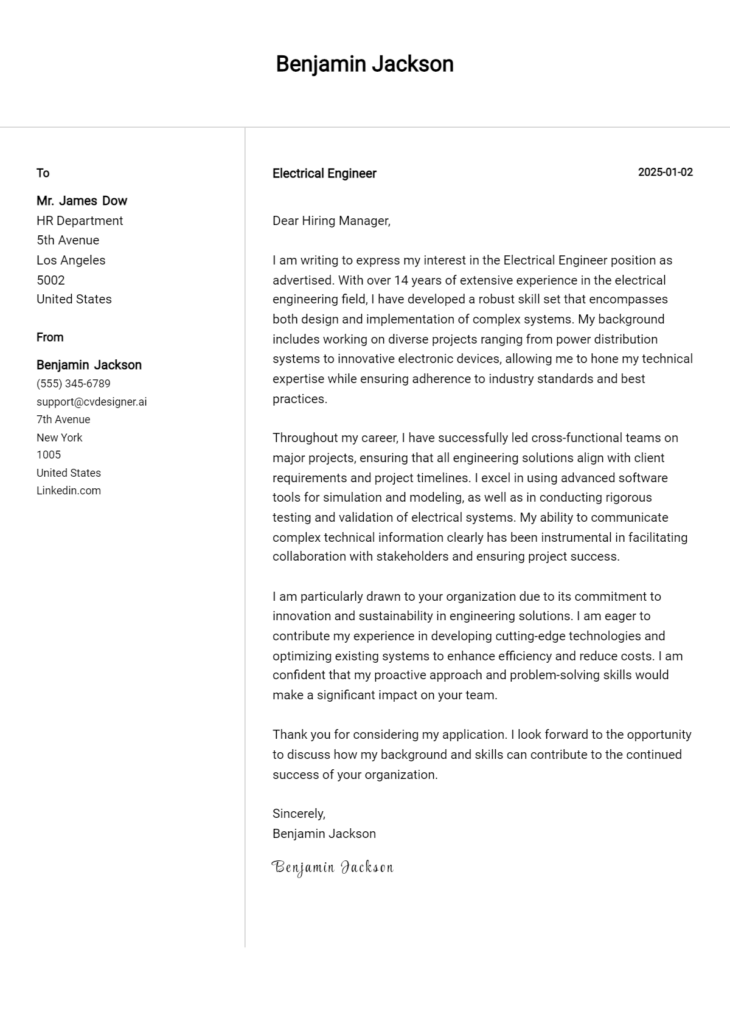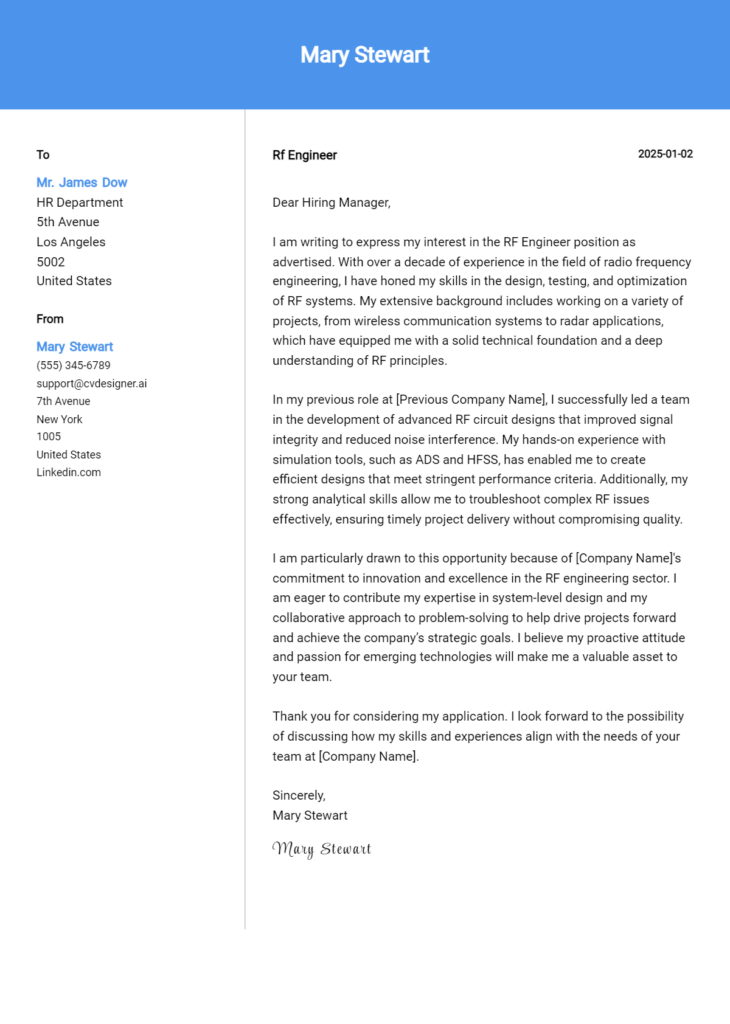Signal Processing Engineer Cover Letter Examples
Explore additional Signal Processing Engineer cover letter samples and guides and see what works for your level of experience or role.
How to Format a Signal Processing Engineer Cover Letter?
Crafting a compelling cover letter for a Signal Processing Engineer position goes beyond merely listing your technical skills and experiences. The way you format and present your cover letter can greatly influence a hiring manager's first impression. A well-structured cover letter reflects your attention to detail, problem-solving abilities, and professionalism—qualities that are essential in the field of signal processing.
In this guide, we will explore the key components of an effective cover letter, providing valuable insights and examples tailored specifically for Signal Processing Engineers.
We will focus on the essential elements of a professional cover letter, including:
- Cover Letter Header
- Cover Letter Greeting
- Cover Letter Introduction
- Cover Letter Body
- Cover Letter Closing
Each section plays a crucial role in emphasizing your qualifications and enhancing your appeal as a candidate. Let’s delve into each part and learn how to make your cover letter shine in the competitive world of signal processing.
Importance of the Cover Letter Header for a Signal Processing Engineer
The cover letter header is a crucial element for any job application, especially for a Signal Processing Engineer, as it sets the tone for the entire document. A well-organized header provides clear and professional communication, making it easy for the hiring manager to identify who you are and how to reach you. It typically includes your contact information, the date, and the recipient's details. Clarity and professionalism in the header reflect your attention to detail and can create a positive first impression.
Here are examples of a strong and weak cover letter header for a Signal Processing Engineer:
Strong Example
Jane Doe 1234 Signal Processing Lane City, State, Zip Code (123) 456-7890 jane.doe@email.com October 1, 2023 Mr. John Smith Hiring Manager Tech Innovations Inc. 5678 Technology Drive City, State, Zip Code
Weak Example
jane1234@gmail.com 10/01/2023 John
Importance of the Cover Letter Greeting
The greeting of a cover letter is crucial in establishing the tone for the rest of your application. It serves as the first impression of your professionalism and can set the stage for how your qualifications are perceived. A well-crafted greeting demonstrates respect and personalization by addressing the hiring manager directly, which can make your application stand out in a competitive job market. To enhance the effectiveness of your cover letter, it's essential to avoid generic greetings such as "To Whom It May Concern" or "Dear Hiring Manager." Instead, take the time to research and find the recipient's name whenever possible. This small effort shows your genuine interest in the position and the company.
Strong Greeting Example
Dear Dr. Smith,
Weak Greeting Example
To Whom It May Concern,
The Importance of a Strong Cover Letter Introduction for a Signal Processing Engineer
A well-crafted cover letter introduction is crucial for a Signal Processing Engineer as it sets the tone for the entire application. This opening paragraph should immediately capture the hiring manager's attention, effectively conveying the candidate's enthusiasm for the role while briefly highlighting relevant skills and achievements. A compelling introduction not only piques interest but also establishes the candidate's qualifications, making it clear why they are a strong fit for the position. Below are examples of both a strong and a weak cover letter introduction.
Strong Example
Dear [Hiring Manager's Name], I am excited to apply for the Signal Processing Engineer position at [Company Name], where I can leverage my expertise in digital signal processing and machine learning to drive innovative solutions. With over five years of experience in developing advanced algorithms that optimize communication systems, I successfully reduced signal interference by 30% in my previous role at [Previous Company]. I am eager to bring my passion for cutting-edge technology and proven track record of results to your esteemed team.
Weak Example
To Whom It May Concern, I am writing to apply for the Signal Processing Engineer job. I have some experience in signal processing, and I think I might be a good fit for the position. I have worked on a few projects related to this field, but I am not sure if they will be relevant.
Purpose of the Cover Letter Body for a Signal Processing Engineer
The cover letter body for a Signal Processing Engineer serves as a crucial platform to present the candidate's technical prowess, relevant experiences, and unique contributions that align with the prospective employer's needs. This section allows the candidate to delve into specific projects or accomplishments that demonstrate their ability to tackle complex signal processing challenges, utilize advanced algorithms, and contribute to innovative solutions. By providing concrete examples, the candidate can effectively convey their value to the company and how their background aligns with the job requirements.
Strong Example
In my previous role at XYZ Technologies, I successfully developed an adaptive filtering algorithm that improved noise reduction in audio signals by 30%, significantly enhancing the clarity of voice communications. This project not only showcased my technical skills in MATLAB and Simulink but also demonstrated my ability to lead a cross-functional team. Additionally, I published a paper on advanced signal processing techniques in a peer-reviewed journal, which further solidified my expertise and commitment to the field. My hands-on experience with real-time signal processing systems uniquely positions me to contribute to your team and drive innovative solutions at ABC Corp.
Weak Example
I have experience in signal processing and have worked on various projects. I am familiar with MATLAB and some other tools. I think I would be a good fit for the job. I like working with teams and hope to contribute to your company.
Importance of Cover Letter Closing for a Signal Processing Engineer
The closing paragraph of a cover letter is crucial as it summarizes your qualifications, reiterates your enthusiasm for the position, and encourages the hiring manager to take the next steps, such as reviewing your resume or scheduling an interview. A strong closing can leave a lasting impression, while a weak one may diminish the impact of your application.
Strong Example
Thank you for considering my application for the Signal Processing Engineer position. With my extensive experience in digital signal processing and a proven track record of developing innovative solutions, I am excited about the opportunity to contribute to your team. I am eager to discuss how my skills can align with your goals and would welcome the chance to schedule an interview at your convenience. I look forward to the possibility of working together.
Weak Example
Thanks for reading my letter. I hope you like my resume. Please let me know if you want to talk.
Crafting an effective cover letter is essential for Signal Processing Engineers looking to stand out in a competitive job market. This document not only provides an opportunity to present your technical skills and problem-solving abilities but also allows you to demonstrate your knowledge of the Software Development Life Cycle (SDLC), teamwork experience, and passion for continuous learning. Here are some tips to help you create a compelling cover letter that highlights these key areas.
Tips for Writing a Cover Letter for Signal Processing Engineer
Highlight Technical Expertise Emphasize your proficiency in signal processing algorithms, tools, and programming languages such as MATLAB, Python, or C++. Clearly describe specific projects where you applied these skills, detailing the challenges you faced and how you overcame them. This not only showcases your technical abilities but also your hands-on experience in the field.
Showcase Problem-Solving Skills Signal Processing Engineers often encounter complex problems that require innovative solutions. Use your cover letter to narrate a scenario where you successfully identified a problem, analyzed it, and implemented a solution. This will demonstrate your analytical thinking and capability to tackle challenges effectively.
Demonstrate Knowledge of SDLC Illustrate your understanding of the Software Development Life Cycle by referencing your experience with different stages, from requirements gathering to testing and deployment. Discuss how you have contributed to each phase in your previous roles, emphasizing your ability to work within a structured development environment.
Emphasize Teamwork and Collaboration Signal Processing Engineers frequently work in teams, so it’s important to highlight your collaborative skills. Share experiences where you effectively communicated with cross-functional teams, contributed to group projects, or mentored peers. This not only shows your ability to work well with others but also your leadership potential.
Convey a Passion for Continuous Learning The field of signal processing is constantly evolving, and employers value candidates who are committed to staying current with industry trends and advancements. Mention any relevant certifications, courses, or workshops you have pursued, along with your enthusiasm for ongoing education. This demonstrates your commitment to professional growth and adaptability in a fast-paced environment.
By incorporating these tips into your cover letter, you can create a strong narrative that will capture the attention of hiring managers. If you need additional guidance, consider using cover letter templates or a cover letter builder to help you structure your document effectively.
Common Mistakes to Avoid in a Signal Processing Engineer Cover Letter
Crafting a compelling cover letter is essential for anyone applying for a Signal Processing Engineer position, as it serves as your first impression to potential employers. Avoiding common mistakes can significantly enhance your chances of standing out. Here are some pitfalls to steer clear of:
Generic Greetings: Using "To Whom It May Concern" can come off as impersonal. Always try to find the hiring manager's name for a more direct approach.
Lack of Specificity: Failing to mention specific skills or experiences related to signal processing can make your application forgettable. Tailor your cover letter to highlight relevant projects or technologies.
Excessive Length: A cover letter should be concise, ideally one page. Avoid lengthy paragraphs that dilute your key messages. Follow a clear cover letter format to stay organized.
Ignoring the Job Description: Not addressing the requirements outlined in the job posting can make it seem like you didn’t pay attention. Use keywords from the job description to demonstrate alignment.
Poor Language and Grammar: Typos and grammatical errors can undermine your professionalism. Always proofread your letter multiple times or use grammar-checking tools.
Failure to Showcase Passion: Not conveying your enthusiasm for the role and the company can make your application feel flat. Share a brief story or motivation for pursuing a career in signal processing.
Neglecting to Include Achievements: Simply listing duties from previous roles fails to impress. Instead, incorporate measurable achievements that showcase your impact in past positions.
By avoiding these common mistakes and following best practices, you can create a persuasive cover letter that effectively highlights your qualifications. For inspiration, check out some cover letter examples to guide your writing process.
Cover Letter FAQs for Signal Processing Engineer
What should I include in my cover letter as a Signal Processing Engineer?
In your cover letter, you should include your educational background, relevant work experience, and specific skills related to signal processing. Highlight your proficiency in programming languages such as MATLAB, Python, or C++, as well as your experience with software tools like Simulink or LabVIEW. Additionally, showcase any projects or research that demonstrate your ability to apply signal processing techniques to real-world problems. It's also beneficial to mention your understanding of communication systems, filtering, and data analysis. Tailor your cover letter to the job description by directly linking your experiences to the requirements of the role. Finally, express your enthusiasm for the company and the specific position.
How can I tailor my cover letter for a specific job application?
To tailor your cover letter, begin by thoroughly reading the job description. Identify key skills and qualifications the employer emphasizes, then highlight similar experiences in your background. Use specific examples from your academic or professional history that align with the job's requirements, such as successful projects involving signal filtering or data compression. Mention the company’s recent innovations or projects and explain how your expertise can contribute to their goals. Avoid generic phrases; instead, personalize your cover letter to reflect your genuine interest in the role and the company. This approach demonstrates that you’ve done your research and are invested in the opportunity.
Should I include technical jargon in my cover letter?
Yes, including relevant technical jargon can be beneficial, but use it judiciously. As a Signal Processing Engineer, showcasing familiarity with industry-specific terminology can demonstrate your expertise and understanding of the field. However, ensure that the jargon is appropriate for the audience. If you know that the hiring manager has a technical background, using specific terms related to algorithms, signal analysis, or machine learning can be advantageous. Conversely, if the letter might be read by HR personnel, balance the technical terms with clear explanations to ensure your competencies are understood. Ultimately, aim for a blend of professionalism and clarity.
How important is the format of my cover letter?
The format of your cover letter is crucial as it reflects your professionalism and attention to detail. A well-organized letter enhances readability and makes a positive impression. Start with your contact information at the top, followed by the date and the employer's information. Use a standard font like Arial or Times New Roman, and maintain a font size between 10 and 12 points for clarity. Keep your paragraphs concise and focused, ideally no more than four to five sentences each. Use a formal greeting and closing. Additionally, ensure there are no typos or grammatical errors, as these can detract from your credibility as a candidate.
Build your Cover Letter in minutes
Use an AI-powered cover letter builder and have your letter done in 5 minutes. Just select your template and our software will guide you through the process.

